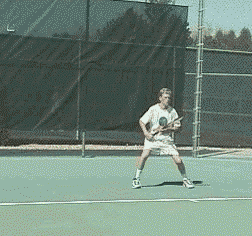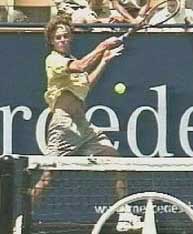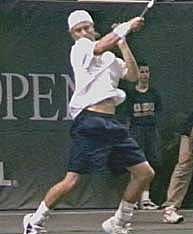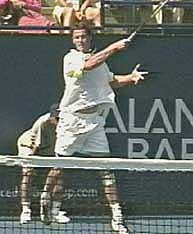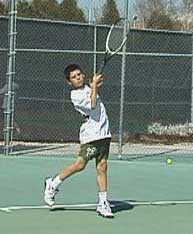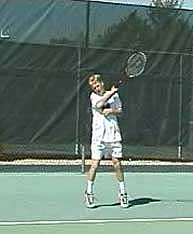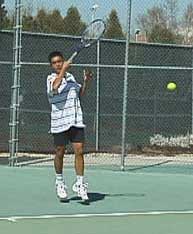<% ns_puts [mkm_getnavbar] %>
The Myth of the Wrap
by John Yandell
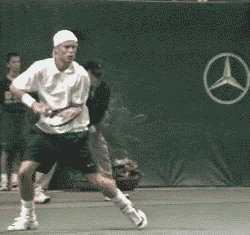 |
|
|
“Show me the butt of the racquet!”
Visit almost any junior academy and you’ll see dozens of eager younger
players trying hard to whip the racquet head up and over the shoulder and
point the butt of the racquet at the instructor.
It’s a mantra in junior coaching. The exaggerated “wrap” follow-through is
widely advocated as the magic key to “racquet head acceleration” in the
modern topspin forehand.
All the top players have big “wrap” finishes, right? So shouldn’t other
players copy them by trying to wrap the finish?
The answer is no. The belief that the “wrap” finish creates racquet head
acceleration is a myth. In fact, the truth is probably exactly the opposite.
The wrap isn’t the cause of a good forehand, it’s an effect. By trying to wrap the finish, junior players are changing the fundamental shape of their swings in a way that has significant negative consequences.
Their forehands may appear similar to top pros. But video analysis shows some startling, critical differences.
Despite their “westernized” grips, players such as Gustavo Kuerten, Marat Safin, and Lleyton Hewitt all have remarkable extension through the contact zone.
By this I mean the racquet continues outward along the line of the shot, reaching a characteristic finish position before the start of the wrap. As the still photos below show, despite variations in grip, backswing, etc, all 3 players reach remarkably similar positions at this point of greatest extension. The wrap occurs only after they have reached this fully extended position.
The movement of the racquet along the line of the shot is the critical factor in racquet head acceleration and ball speed. In my opinion this finish position at the point of maximum forward extension should be considered the end of the technical swing pattern. Everything that happens thereafter (i.e., the wrap) should be considered a reaction or a consequence, and part of the recovery for the next shot.
Let’s compare the finishes of these 3 pro players to 3 junior players
with similar grip styles. These are typical examples of the dozens of
sectionally and nationally ranked players I have filmed who have what I call
mechanical wraps. Click on the photos above and you will see exactly what I
am talking about. Study the pro player and the junior with the corresponding
grip style. Click through the video frame by frame and you will see the
differences in the extension of the motion.
The juniors simply don’t extend through the hitting zone in the same way. Their
racquets come off the line of the shot much sooner. Note how much less
extension all three players have compared to the pros with similar grip
styles. Their strokes look almost collapsed as if the racquet had been
forced backwards toward the body.
None reach the characteristic finish position of Guga, Hewitt, or Safin.
This is the telltale indication of the forced, or mechanical wrap. Instead
of hitting all the way through the ball, they pull rapidly off the shot,
trying to force or muscle the racquet into the wrap position.
Their swing planes are shorter and steeper. Often they generate a lot of
topspin, but they tend to lack depth and pace. Their balls just don’t
penetrate the court, despite what appears to be great effort in making the
swing.
Of all the myths and misguided beliefs that I see in teaching and coaching,
I have to say this is one of the most counterproductive. I can’t stand to
watch junior players with mechanical wraps for more than a few balls.
Sometimes it actually makes me feel physically ill, because I see so many
players laboring under the same delusion.
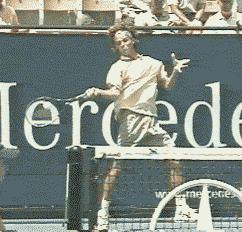 |
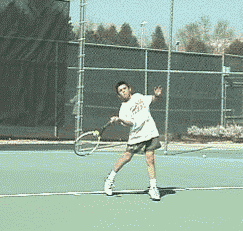 |
| Compare the extension between Guga and this junior player with a similar grip. |
This is why, when I do video clinics for elite juniors, I hear top coaches
like Elliot Teltscher criticize the shape of the followthrough in one
talented player after another.
In the physical world, for every action, there’s an equal and opposite
reaction, and in tennis, the reaction to a great, positive forward swing on
the forehand is a relaxed, fluid wrap. It’s not something players should try
to make happen.
Research shows that the wrapping phase of the forehand has nothing to do with racquet head acceleration. Advanced Tennis measurements show that during the wrap, the racquet is not accelerating. Actually, it’s the opposite.
During the wrap, the racquet head is decelerating, and decelerating radically. At the completion of the wrap, the racquet head speed drops to the lowest point in the entire stroke—about 10% of the maximum racquet head speed or less. During the wrap the racquet is moving more slowly than at the start of the backswing!
It makes sense when you think about it. How could the wrap actually be
part of a positive forward swing when the racquet is moving backwards?
Why would a player purposefully try to swing the racquet in the opposite
direction that he was trying to hit the ball? With the great players, the
energy is directed into the forward swing and the wrap just happens.
If you know to look for it, you can learn to see these differences with the naked eye. Players with a natural wrap seem smooth, and the motion has a natural looking shape and extension. Players with an artificial wrap look mechanical and cramped.
You can almost see these players picking the racquet up and forcing it to
what they believe is the correct “wrapped” finish position. But there is a
big difference between trying to wrap and letting the wrap happen.
So the mantra of junior tennis, “show me the butt of the racquet,” is
well-intentioned, but misguided. Ironically, the traditional emphasis on
hitting through the ball, and extending the follow-through forward and
upward is probably still the key to developing the so-called modern
forehand.
It’s just that with the “westernized” grips the shape of swing and the
hitting arm positions look a little different, and the check points need to
be adjusted accordingly.
This was the principle change Robert Lansdorp made when Russian phenom Maria Sharapova first came to him several years ago. Click here and you can see how Lansdorp trained her to hit through her forehand, when she was just 13, although he didn’t try to change her semi-western grip. It may be the single most important reason she is one of the rising stars on the women’s tour.
Want to study the modern pro forehand in
highspeed video?
Click here for more information about
Advanced Tennis
videos.
Your comments are welcome. Let us know what you think about John Yandell's article by emailing us here at TennisONE.
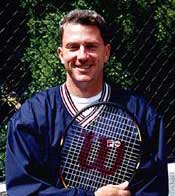 John
Yandell, 49, is TennisONE's CEO as well as a Special Contributing
Editor. He has done on court video analysis for players including
Gabriela Sabatini and John McEnroe, and is the author of the critically
acclaimed tennis instructional book Visual Tennis. John
Yandell, 49, is TennisONE's CEO as well as a Special Contributing
Editor. He has done on court video analysis for players including
Gabriela Sabatini and John McEnroe, and is the author of the critically
acclaimed tennis instructional book Visual Tennis.Yandell is the research director for the Advanced Tennis Research Project which is undertaking a revolutionary study of the physics and bio-mechanics of professional tennis (www.AdvancedTennis.com). Yandell has directed instructional videos with numerous top coaches and players including, Jim Loehr, Allen Fox, Pat Etcheberry, Dick Gould, Frank Brennan, John McEnroe and Ivan Lendl. |
To contact us, please email to: webmaster@tennisone.com
TennisONE is a registered trademark of TennisONE and SportsWeb ONE; Copyright 1995. All rights reserved.


